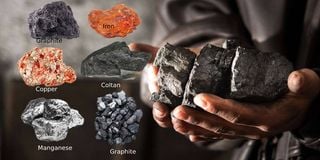Survey reveals Kenya has some 970 minerals

Kenya is sitting on immense underground wealth of 970 minerals.
It has emerged that the country has immense underground wealth after a survey found that there are 970 minerals nationwide.
The minerals have been classified as “potential prospects” for further exploration to establish the nature, economic viability and estimated total worth.
If the process of confirming these critical minerals, first in 15 select counties considered well-endowed, is successful, Kenya will join the league of nations that mine thorium, nickel and cobalt, among others.
The 970 minerals include industrial minerals, base metals, precious metals, rare earth and radio-active minerals, gemstones, construction and building materials, and geothermal resources.
“This number is likely to increase at completion of survey of the entire country landmass,” Cabinet Secretary for Mining, Blue Economy and Maritime Affairs Salim Mvurya announced yesterday.
The 15 counties identified as having the highest prospects of the identified minerals will be subjected to the further study— referred to as ground truthing—that will inform exploration decisions. The devolved units have copper, graphite, manganese, iron ore, coltan, base metals, nickel chromite, lead, zinc, rare earth elements, uranium, thorium, nickel-cobalt.
The counties with these minerals are Kitui, Embu, Tana River, Kilifi, Isiolo, Makueni, Taita-Taveta and Kwale in the Coastal belt. Others are Homa Bay, West Pokot, Turkana, Samburu, Elgeyo-Marakwet, Nandi and Kericho in Western region.
“There is need for field based physical checks that will aid in building more global exploration models and that’s why from next week we will have our officers in these counties to ascertain the minerals found in them,” said Mr Mvurya.
He told a consultative meeting with governors from the 15 counties that the finding followed a geophysical survey that ended Kenya’s 30-year quest to map out minerals.
“Upon confirming availability of economically viable deposits, residents and county governments will then be engaged in providing consents to mining companies ahead of the ministry granting exploration and mining licences,” he said.

Mining, Blue Economy and Maritime Affairs Cabinet Secretary Salim Mvurya (centre) with West Pokot Governor Simon Kachapin (left) and Kitui Governor Julius Makau Malombe in Nairobi yesterday.
According to the Mining Act, 2016, sharing of mineral royalties is at a ratio of 70 per cent to the national government, 20 per cent to the county government and 10 per cent to the communities.
However, the Act does not provide for the modalities of sharing the royalties once they have been collected. Due to this legal gap, counties and communities have not received their share of mineral royalties collected since 2016. All royalties collected by the ministry since then— Sh14.7 billion—have been transmitted to the exchequer.
However, the Allocation of Additional Funds Act that has just been signed into law will now facilitate counties to access their 20 per cent of the withheld funds, which translates to Sh2.9 billion.
With regard to the 10 per cent share to communities, the ministry has constituted a task force that is set to develop the regulations by end of this month.
“Counties will be engaged for their comments on the draft regulations before they are adopted,” Mr Mvurya said.
The data collection, conducted aerially, commenced in April 2021 and ended in July last year having covered an area of 538,420km2 onshore.
At the same time, Mr Mvurya said authorities will revive artisanal mining committees in various counties, which will issue permits.
“We have decided to form cooperative societies so that then they can help artisanal miners in doing their business. We want to build the capacity of artisanal miners to enhance sustainable mining operations and promote effective participation in the mineral value chain. We also want to strengthen the participation of women and youth through the entire artisanal value chain, including trading,” said Mr Mvurya.
According to the Kenya National Chamber of Commerce and Industry, the mining sector currently contributes less than 1 per cent of Kenya’s GDP but has potential capacity to contribute 4 to 10 per cent.
“Our aim is to make sure that the mining sector adds and contributes to the economic growth of our country, and also benefits the residents living in those areas with minerals,” added Mr Mvurya.





